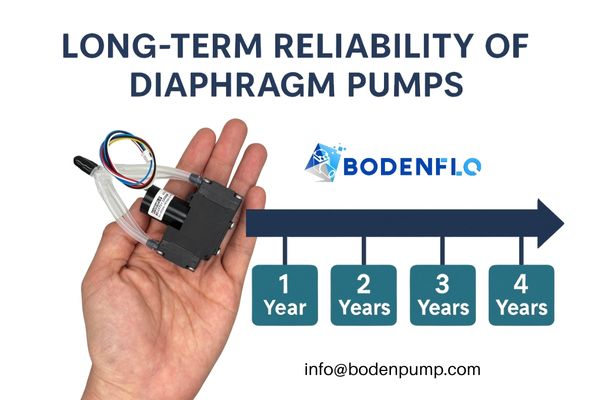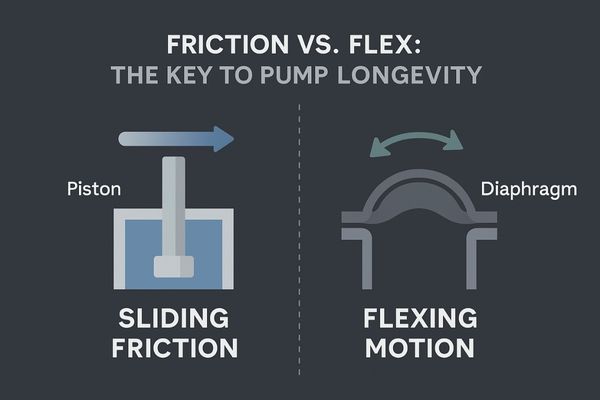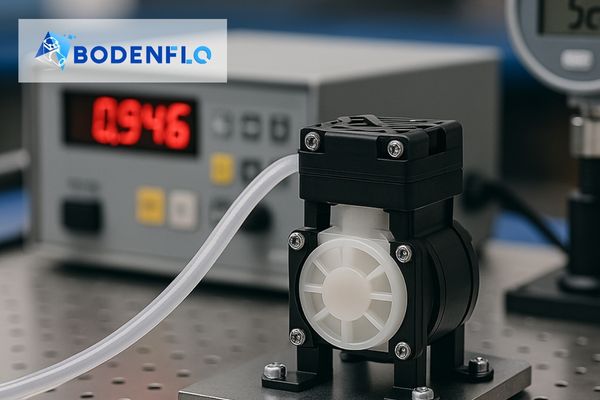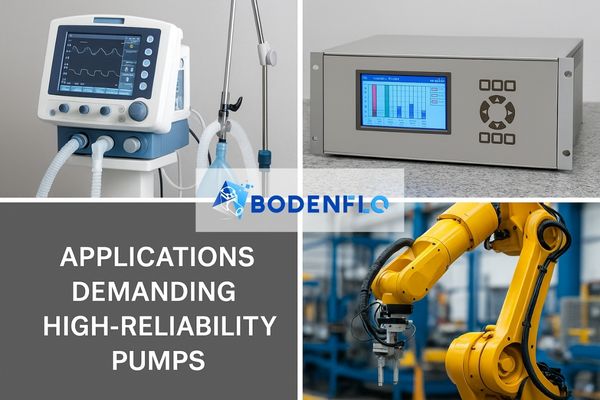Your product is out in the field, but you're getting reports of early failures. The cause? A tiny, inexpensive pump that just couldn't last, damaging your brand's reputation and leading to costly returns.
Diaphragm pumps are exceptionally reliable, specifically because their design eliminates the most common points of failure found in other pump types. With no sliding friction in the air path and the use of advanced motors, premium models are engineered to run for over 10,000 hours without maintenance.

I've spoken with countless engineers who switched to diaphragm pumps after a bad experience with another technology. They learned the hard way that a pump's initial cost is nothing compared to the cost of failure. The reliability of a diaphragm pump isn't magic; it's the result of smart engineering choices that directly target and eliminate the causes of wear and tear. Let's break down exactly where that reliability comes from.
What's the Secret to Their Long Lifespan?
You see a piston pump and a diaphragm pump side-by-side. They seem to do the same job, but one is rated for 3,000 hours and the other for 10,000. This massive difference seems too good to be true.
The secret is the elimination of sliding friction. A diaphragm pump works by flexing a membrane, not by rubbing a seal against a wall. This fundamental design difference drastically reduces wear, heat, and part fatigue, extending its operational life by thousands of hours.

The Physics of Failure
To understand why diaphragm pumps1 are so reliable, we first need to look at why other pumps fail. The number one enemy of any mechanical device is a combination of friction and heat.
The Friction Failure Point in Piston Pumps2
In a miniature piston pump, a seal is constantly sliding back and forth against the inside of a cylinder.
- Constant Wear: Every single stroke grinds away a microscopic amount of the seal. Over millions of cycles, this adds up, and the seal begins to leak, reducing performance until the pump fails.
- Heat Generation: This friction also generates heat, which can cause the materials to degrade even faster.
This sliding seal is the pump's built-in weak link.
The Flex-for-Life Design of Diaphragm Pumps
Our diaphragm pumps are designed to avoid this problem entirely.
- Frictionless Motion: The diaphragm is a highly engineered disc of elastomer (like EPDM). It is clamped at the edges and flexed by a connecting rod on a bearing. There are no sliding parts in the air path.
- Engineered Endurance: We use advanced compounds specifically designed to withstand billions of flex cycles without cracking or losing elasticity. The main moving parts—the diaphragm and the valves—are designed for maximum durability.
Does the Motor Choice Affect Pump Reliability?
You specified a high-end pump head, but the complete unit still failed prematurely. The pump head looked fine, but the motor was dead, making the entire device useless and leaving you wondering what went wrong.
Yes, the motor is the heart of the pump and is absolutely critical to its overall reliability. A premium brushless DC (BLDC) motor eliminates physical brush wear, the most common motor failure point, enabling the pump to reach its full potential lifespan of 8,000 hours or more.

The Engine Driving Reliability
A great pump head is useless without a motor that can keep up. At BODENFLO, we match our pump heads with the right motor technology for the job. Choosing the right motor is just as important as choosing the right pump.
1. The Standard Workhorse: Brush Motors
These are traditional DC motors, cost-effective and suitable for standard lifecycles or intermittent use. Their weak point is the carbon brushes, which physically rub on a commutator and wear down over time. This is why pumps with brush motors typically have lifespans in the 2,500 to 5,000-hour range.
2. The Endurance Champion: Brushless DC (BLDC) Motors3
This is the gold standard for high-reliability applications. BLDC motors use electronics instead of brushes, eliminating the primary wear component. This results in massive lifespans (8,000 to 20,000 hours), higher efficiency, and quieter operation. For any device that needs to run 24/7 or where failure is not an option, a brushless motor is the only real choice.
3. The Compact Specialist: Coreless Motors4
These are a special type of motor where the heavy iron core is removed from the rotor. This makes them incredibly lightweight, compact, and energy-efficient. Their low-inertia design leads to a very long life for their size, often 6,000-8,000 hours. They are the perfect reliability choice for battery-powered, portable devices.
Is a Good Design Enough to Guarantee Reliability?
You're looking at two pumps with nearly identical designs on their spec sheets. One is from a trusted brand, the other is a low-cost alternative. You wonder if the brand name is the only real difference.
No. A great design is just the starting point. True reliability comes from a deep commitment to manufacturing quality—using consistent, high-grade materials, precision assembly, and rigorous testing of every single pump before it leaves the factory.

The Unseen Factors of Reliability
I've toured countless factories, and I can tell you that what happens on the assembly line is just as important as what happens on the design screen. This is where a brand's commitment to quality is truly tested.
1. Material Consistency is Key5
A diaphragm's reliability depends on the exact chemical compound of its elastomer. We source our materials from top-tier suppliers and enforce strict quality control to ensure that the diaphragm in the ten-thousandth pump is identical to the first. A cheaper pump might use lower-grade materials that will become brittle prematurely.
2. Precision in Assembly6
How a pump is put together matters. Are the screws torqued to the exact specification? Is the diaphragm seated perfectly? We use a combination of automated processes and trained technicians to ensure that every pump is assembled to the same exacting standard.
3. The Final Proof: 100% End-of-Line Testing
This is non-negotiable for us. Every single BODENFLO pump is connected to a testing rig before it's packaged. We test it for its target flow, pressure, and vacuum levels. If a pump doesn't meet its specifications perfectly, it doesn't ship. Our UKAS ISO 9001:2015 certification is your external proof of this commitment.
Where is This Reliability Most Critical?
You understand that the pump is reliable, but you're not sure how that translates into value for your specific project. Does a longer lifespan really matter for your application?
This extreme reliability is most critical in applications where failure has serious consequences. In medical devices, gas analysis, and 24/7 industrial automation, pump failure can compromise patient safety, invalidate critical data, or cause costly downtime.

When Failure is Not an Option
The demand for reliability isn't just about convenience; it's about performance and safety. In some fields, it's the single most important pump specification.
Medical Devices: Consider a negative pressure wound therapy device7 or a portable oxygen concentrator. These devices are directly responsible for a patient's treatment and well-being. A pump failure is not an inconvenience; it's a medical incident. The long, predictable life of a diaphragm pump is essential for patient safety and regulatory approval (CE, RoHS).
Scientific & Laboratory Instruments: Imagine a gas chromatograph running a 24-hour analysis of a critical sample. If the vacuum pump8 fails halfway through, the entire sample and all the data are lost, wasting thousands of dollars in time and materials. Consistent, reliable vacuum is necessary for data integrity.
Industrial Automation: In a production line, a single pump in a robotic pick-and-place head might perform millions of cycles a month. If that pump fails, the entire line can shut down, costing the company thousands of dollars for every hour of downtime. Here, reliability means profitability.
How Do We Quantify Pump Reliability?
You see "Lifetime: 8,000 Hours" on a spec sheet, but what does that number really mean? You're worried it's just a marketing figure, not a reliable metric for your engineering calculations.
The lifespan rating, often based on Mean Time Between Failures (MTBF), is a statistical average derived from extensive, real-world testing. It represents the point at which a population of pumps will start to see failures under specified operating conditions.
Understanding the Numbers
That lifespan number isn't pulled out of thin air. It's the result of a rigorous engineering and testing process designed to give you a realistic expectation of performance.
What is MTBF? Mean Time Between Failures9 is a standard reliability metric. To determine it, we run a large batch of pumps under their intended load (pressure or vacuum) continuously, 24/7, for thousands of hours. We carefully monitor their performance and record when each unit fails. The total operational hours divided by the number of failures gives us the MTBF.
It's a Marathon, Not a Sprint: This testing is brutal. The pumps run in test chambers for months on end. This allows us to identify any potential weaknesses in the design, materials, or motor long before the product ever reaches a customer.
Conservative Ratings: At BODENFLO, we believe in providing conservative and realistic lifespan ratings. We test under real-world loads, not just "free-flow" conditions. An 8,000-hour rating on a brushless pump means you can confidently design it into a system intended for years of continuous or intermittent service, knowing it has been proven to endure.
Are There Any Weaknesses to Consider?
You're convinced of the mechanical reliability, but you're worried about overlooking a hidden weakness. Can a diaphragm pump still fail even if the design is solid and the motor is good?
Yes. While mechanically robust, a diaphragm pump's reliability can be compromised if used outside its specified limits. The most common issues arise from chemical incompatibility with the diaphragm material or from operating in extreme temperatures.
Choosing the Right Tool for the Job
A reliable pump can become unreliable if it's used for the wrong task. Ensuring long life means paying attention to two key environmental factors.
1. Chemical Compatibility10: The diaphragm is the heart of the pump, and it must be compatible with the gas or fluid it's moving. Our standard diaphragms are made of EPDM, which has excellent resistance to water and many common substances. However, if you are pumping aggressive solvents or ozone, you would need a pump with a special diaphragm made from a material like Viton (FKM) or PTFE. Using the wrong material will cause the diaphragm to swell, harden, or crack, leading to premature failure. It's crucial to check a compatibility chart or consult with our engineers.
2. Operating Temperature11: Both the pump materials and the motor have an optimal operating temperature range. Running a pump in an environment that is too hot or too cold can affect performance and lifespan. Excessive heat can accelerate the aging of the elastomer diaphragm and put extra strain on the motor. Extreme cold can cause materials to become stiff, reducing their flexibility. Always operate within the specified temperature range to ensure reliability.
Conclusion
Diaphragm pump reliability is the result of a frictionless design, durable materials, superior motor technology, and an unwavering commitment to quality manufacturing. This makes them the trusted choice for critical applications.
Looking for a pump partner who values reliability as much as you do?
BODENFLO specializes in custom micro diaphragm pumps for medical, industrial, and analytical applications.
📧 Contact us: info@bodenpump.com
BODENFLO – Engineering Reliability Into Every Pump
-
Explore the advantages of diaphragm pumps, including their reliability and durability compared to traditional pumps. ↩
-
Understanding friction failure in piston pumps can help you appreciate the design advantages of diaphragm pumps. ↩
-
Explore the benefits of BLDC motors for high-reliability applications, including efficiency and lifespan. ↩
-
Learn about Coreless Motors' lightweight design and energy efficiency, ideal for portable devices. ↩
-
Understanding material consistency can enhance your knowledge of quality control in manufacturing processes. ↩
-
Exploring precision in assembly will provide insights into how meticulous assembly impacts overall product reliability. ↩
-
Explore this link to understand how these devices enhance patient care and safety in medical treatments. ↩
-
Learn about the critical role of vacuum pumps in preserving data quality and preventing costly losses in laboratory settings. ↩
-
Understanding MTBF is crucial for evaluating product reliability and performance, making this resource invaluable for informed decision-making. ↩
-
Understanding chemical compatibility is essential for selecting the right pump and ensuring its longevity. ↩
-
Exploring the impact of operating temperature can help you maintain pump efficiency and extend its lifespan. ↩


